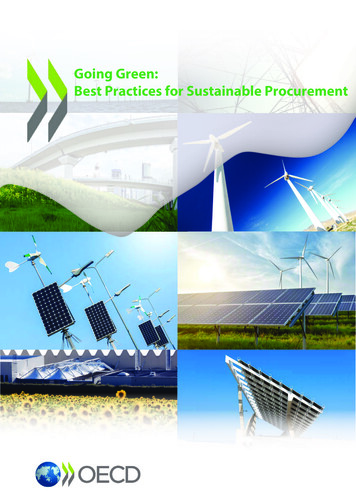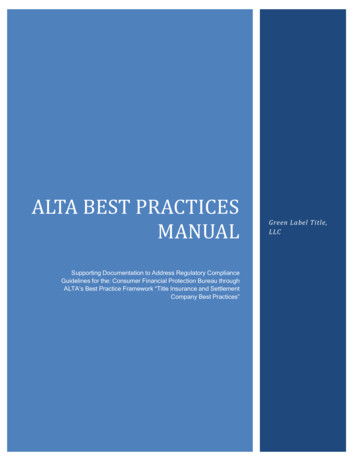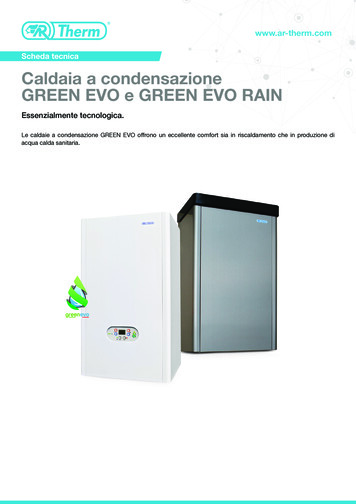
Transcription
Going Green:Best Practices for Sustainable Procurement
GOING GREENBEST PRACTICES FOR SUSTAINABLE PROCUREMENT
This work is published under the responsibility of the Secretary-General of the OECD. The opinionsexpressed and arguments employed herein do not necessarily reflect the official views of OECDmember countries.This document and any map included herein are without prejudice to the status of or sovereignty overany territory, to the delimitation of international frontiers and boundaries and to the name of anyterritory, city or area.Photo credit: ArtisticPhoto/Shutterstock.com / Maciej Bledowski/Shutterstock.com / artjazz/Shutterstock.com / ksl/Shutterstock.com / Eugene Suslo/Shutterstock.com / GubinYury/Shutterstock.com2
TABLE OF CONTENTSGOING GREEN: BEST PRACTICES FOR SUSTAINABLE PROCUREMENT . 5DIMENSION 1. GREEN PUBLIC PROCUREMENT LEGAL AND POLICY FRAMEWORK9Korea . 9Austria . 12DIMENSION 2. UNDERSTANDING MARKET CAPACITY AND ASSESSING COSTSAND BENEFITS. 15India . 15Italy . 20DIMENSION 3. INTRODUCING ENVIRONMENTAL STANDARDS IN PROCUREMENT24People’s Republic of China . 24Estonia . 26Netherlands . 29Austria . 33Denmark . 35Sweden. 36DIMENSION 4. PROFESSIONALISING GPP . 41Belgium . 41Slovak Republic . 44Austria . 46DIMENSION 5. RAISING AWARENESS . 49Hungary . 49Portugal . 51Austria . 54DIMENSION 6. MONITORING GPP . 57Canada . 57Italy . 62United States . 66Austria . 70France . 713
TablesTable 1.Table 2.Table 3.Table 4.Table 5.Comparison of life-cycle costing for compact fluorescent lamps andincandescent lamps .16Impact and monitoring, Portugal, green procurement 2009-10 .53Example of PC desktop life-cycle costing.63Replacement of 1 PC desktop with 1 portable computer (LCC) .64Use of the framework agreements in IT for government .65FiguresFigure 1.Figure 2.Figure 3.Trends in total amount of green public procurement in Korea .11Profits under Hedensted Municipality’s new heating and cooling system .36Data collected from Swedish EPA studies conducted in 2004, 2007, 2009and 2013 .394
GOING GREEN: BEST PRACTICES FOR SUSTAINABLE PROCUREMENTThe OECD has launched a new agenda on public procurement reform to support countries increating an overarching approach to procurement that enables efficiency, fosters growth andaccomplishes their strategic goals. As part of this agenda, the OECD replaced the 2008Recommendation of the Council on Enhancing Integrity in Public Procurement1 by theRecommendation of the Council on Public Procurement [C(2015)2 and C/M(2015)4, Item 28] ,aiming to encourage a balanced approach to the use of procurement as a smart governance tool toachieve economy, efficiency and secondary policy objectives. Green public procurement (GPP), i.e.public purchasing of products and services which are less environmentally damaging 2 when takinginto account their whole life cycle,3 is increasingly used by countries to achieve such policy objectivesin the area of environmental protection.The compendium is a contribution of the Public Governance Committee to the OECD GreenGrowth Strategy. It is aligned with G20 priorities and the Compendium of Good Practices for Integrityin Public Procurement prepared by the OECD and endorsed by the G20 Anti-corruption WorkingGroup in Rome on 9-10 June 2014. The compendium is part of the 2013-14 Programme of Work andBudget of the Public Governance Committee4, contributing in particular to the analysis of lessonslearnt by countries in using public procurement as a strategic lever to support government objectives,in this case environmental policy objectives.Countries have reported to the OECD that they face obstacles to successfully implementing GPP,including in particular: the perception that green products and services may be more expensive than conventionalones; public officials’ lack of technical knowledge on integrating environmental standards in theprocurement process and the absence of monitoring mechanisms to evaluate if GPP achieves its goals.5However, countries increasingly recognise that GPP can be a major driver for innovation,providing industry with incentives for developing environment-friendly works, products and services,1OECD (2008), OECD Recommendation of the Council on Enhancing Integrity in Public Procurement,C(2008)105,OECD, Paris, available at: w.aspx?InstrumentID 131&Lang en&Book False.2OECD (2002), OECD Recommendation of the Council on Improving the Environmental Performance of PublicProcurement, C(2002)3, OECD, Paris, available at: w.aspx?InstrumentID 46&InstrumentPID 43&Lang en&Book False.3Green public procurement is defined in the EU as “a process whereby public authorities seek to procure goods,services and works with a reduced environmental impact throughout their life cycle when compared to goods,services and works with the same primary function that would otherwise be procured”, European Commission(2008), Communication “Public procurement for a better environment”, European Union, Brussels, ri COM:2008:0400:FIN:EN:PDF.4OECD (2012), “Programme of WorkGOV/PGC(2012)3/REV2, OECD, Paris.5See: �,
particularly in sectors where public purchasers represent a large share of the market, such asconstruction, health services or public transport.6Countries highlighted a particular challenge in the monitoring report on the implementation of the2008 Recommendation of the Council on Enhancing Integrity in Public Procurement: the risk ofoverloading procurement with policy objectives such as environmental protection, in addition to theprimary objective of public procurement to deliver necessary public goods and services in a timely,economical and efficient manner that allows for fair competition.7 Countries pointed out the risk ofdisrupting the efficiency of buying processes where procurement is used to support socio-economicgoals without a prior analysis that assesses short- and long-term costs and benefits and verifieswhether procurement is indeed the most effective tool to achieve policy objectives, compared to othertools like regulations or taxation. Therefore, when governments use public procurement to supportgoals like environmental protection, there should be an evaluation to ensure that this is efficient and inorder to draw lessons for future policy development.8To assist countries in their efforts to implement GPP and address challenges, the 2012 report bythe Public Governance Committee to the Council on the implementation of the 2008 Recommendationon Enhancing Integrity in Public Procurement called for the development of a “compendium of goodpractices on how to integrate environmental considerations in public procurement in a transparentand cost-effective manner”.9The analytical framework for collecting the GPP case studies was set in a discussion paper on“Mapping out good practices for green public procurement”10 developed by the OECD in 2013. Theframework is based on the following six dimensions for successful GPP implementation:1.Setting a GPP legal and policy framework to assist buying entities in incorporating GPP intheir procurement procedures.The case studies inform the discussions on the usefulness of a clear GPP framework withunderstandable definitions, targets and priorities in helping public entities achieve their goals.Different national approaches converge in that comprehensive and well-aligned guidance isinstrumental in reaching GPP objectives.2.Planning GPP, including understanding market capacity and available technical solutions aswell as assessing GPP costs and benefits.6European Union (2011), Buying Green! A Handbook on Green Procurement, 2nd Edition, European Union,Brussels, available at: http://ec.europa.eu/environment/gpp/buying handbook en.htm.7“The main objective of public procurement systems is to deliver value for money in the use of public funds whilstadhering to the fundamental principles that guide government actions, in particular transparency andnon-discrimination” (OECD, 2013, Implementing the OECD Principles for Integrity in Public 1787/9789264201385-en).8.Idem.9.10OECD (2012), “Report by the Public Governance Committee on the implementation of the Recommendation ofthe Council on Enhancing Integrity In Public Procurement”, C(2012)98, OECD, Paris; see also OECD (2013),Implementing the OECD Principles for Integrity in Public Procurement: Progress Since 2008, OECD PublicGovernance Reviews, OECD Publishing, Paris, http://dx.doi.org/10.1787/9789264201385-en.OECD (2013), “Mapping out good practices for green public procurement”, GOV/PGC/ETH(2013)3, OECD,Paris, available at: ntpdf/?cote GOV/PGC/ETH(2013)3&docLanguage En.6
The case studies show that consulting with stakeholders and suppliers is crucial to assessavailable green solutions and gauge supply capacity. Countries provided valuable guidance on ways ofengaging with the supply market as well as on how authorities may use life-cycle costs evaluation intheir cost-benefit analysis.3.Introducing environmental standards in the technical specifications, procurement selectionand award criteria, as well as in contract performance clauses.The case studies highlight the extent to which performance-based contracting and paymentprovide incentives for innovative green solutions. Credible standards determining what products orservices count as green, such as, for example, eco-labels, are core conditions to reach environmentalgoals. In the course of consultation for this report, stakeholders have also pointed out the importanceof conducting paperless procurement procedures and thus contribute to environmental goals.4.Professionalising GPP and increasing know-how and skills.Countries are unanimous in that GPP requires specialised knowledge and skilledmultidisciplinary teams. The case studies showcase a range of professionalisation tools like manuals,training and guidance, which help build the capacity of the public sector to use procurementstrategically.5.Raising awareness on GPP solutions and their benefits with buyers, businesses and the civilsociety.A focused effort on getting the right messages across to government procurement officials andthe general public can have a significant impact on the success of GPP. Case studies show concreteresults of GPP communication strategies, including encouraging businesses to develop green solutionsand increasing citizens’ trust in the achievements of green policies.6.Monitoring the results of GPP and providing a feedback loop into policy and regulation.The case studies not only provide concrete examples of measuring and monitoring GPP resultsbut also show that monitoring serves to consolidate the benefits of GPP and provide valuable feedbackfor policy makers.Senior public procurement experts from OECD and key partner countries validated the analyticalframework. The case studies on GPP good practices were selected and sent by OECD and key partnercountries and validated during 2013 and 2014 by, mainly through the meetings of the LeadingPractitioners on Public Procurement of 11-12 February 2013, 7-8 November 2013 and 18 June 2014.11The United Nations Environmental Programme (UNEP) was a valuable partner throughout thisprocess. To promote the collection and dissemination of information, the OECD and UNEP led a jointexpert group on promoting best GPP practices.12 The group is incorporated in the international 10Year Framework of Programmes (10YFP) Sustainable Public Procurement (SPP) Programme. Led bythe (UNEP), the 10YFP SPP Programme convenes a network of over 70 partners representinggovernments, non-governmental organisations (NGOs), consultancies, businesses, internationalorganisations and experts from over 30 countries, has two objectives: i) build the case for SPP/GPP;and ii) support the implementation of SPP on the ground in order to promote sustainable consumptionand production and support greener economies.11See: ge-sharing.htm.12See: ent.htm.7
The first version of this compendium was reviewed at the meeting of the joint OECD-UNEPexpert group on 6 November 2013, carried out under the leadership of the Leading Practitioners onPublic Procurement.13 An updated version was presented in the meeting of Leading Practitioners inPublic Procurement on 18 June 2014.14 This final version compiles all of the GPP case studies andincorporates the valuable comments made by countries, including good practices and challenges inimplementing GPP in a national or sub-national context.This document presents the case studies across the six dimensions of GPP implementation on thebasis of one of their core features. However, most are multidimensional and all are complementary,forming together a comprehensive view of what may constitute good approaches to successful GPP.The case studies are published by the OECD on a dedicated es-for-green-procurement.htm, where the final version ofthis compendium will be made public as soon as approved. Lessons learnt in preparing thiscompendium fed into the development of the Recommendation of the Council on Public Procurement[C(2015)2 and C/M(2015)4, Item 28] and will support its implementation.13OECD (2013), “Case studies on green public procurement best practices”, GOV/PGC/ETH(2013)10, OECD,Paris, available at: 14OECD (2014), “Going green: Best practices for green procurement”, GOV/PGC/ETH(2014)1, OECD, Paris.8
DIMENSION 1. GREEN PUBLIC PROCUREMENT LEGAL AND POLICY FRAMEWORKA solid GPP framework, including regulation and policy guidance, can be a powerful tool inadvancing the purchase of green products and removing obstacles to GPP. Regulatory frameworks relyin variety of tools, from guidelines to schemes to increase ‘market-pull’, incentivising thedevelopment of a green solution.The case studies build a convincing case for clear and well-aligned frameworks. For example, theKorean Act on Encouragement of Purchase of Green Products adopted to harmonise GPP policies wasinstrumental to foster the rapid growth of the green public market. Likewise, the principles and targetsset by the Austrian Railways Infrastructure Corporation helped the successful implementation of GPP.KOREA15Context and objectivesKorea’s green public procurement was first introduced in tandem with the Korea Eco-label underthe Act on Development and Support of Environmental Technology of 1994. State agencies wererecommended to preferentially purchase products awarded the Korea Eco-label. However, it remainedinactive due to the limited number of eco-labelled products and the lack of a monitoring system.Green public procurement took a more concrete form when the Ministry of Environmentintroduced the Act on Encouragement of Purchase of Green Products in 2005 (hereinafter the Act of2005). At the beginning of each year, state organisations – i.e. central and local governments andpublic organisations – are obliged by the Act of 2005 to submit an implementation plan on greenpurchases of the year and the performance records of the previous year to the Ministry ofEnvironment.A series of consultations with the line ministries, public organisations, experts and the industrywere conducted to agree upon the essence of the Act of 2005. It was concluded that green publicprocurement be implemented in connection with the eco-labelling – i.e. Korea Eco-label and GoodRecycled Mark – in order to minimise the administrative costs required to set the green procurementstandards by each institute.The adoption of the Act of 2005 has been instrumental in stimulating the development ofeco-labelled products in both quantity and quality by leveraging the public demand. The total publicexpenditure in green purchases has more than tripled, from KRW 254.9 billion in 2004 to KRW 787billion in 2005, with a further increase to KRW 1 727 billion in 2012. In addition, the number ofproducts certified by the Korea Eco-label increased by 3.8 between 2004 and 2012.ImplementationThe government does not set quantitative targets related to green public procurement, but eachstate agency must set its own voluntary target (e.g. estimated amount of green purchases and15.Case study submitted by the Korean Environmental Industry and Technology Institute (KEITI).9
percentage of green purchases in relation to the total purchases of the year) and report it to theMinistry of Environment. The Ministry of Environment expects the green public market to grow by1.5 times over the three years between 2012 and 2015.The products and services applicable for green public procurement are defined by the Act of 2005as: i) certified or meeting the underlying criteria set by the Korea Eco-label; ii) certified or meeting thecriteria of the quality certificate for recycled products (Good Recycled Mark); iii) complying withother environmental criteria set by the Ministry of Environment following consultation with the headsof the relevant ministries.According to the Act of 2005, state agencies should purchase green products and services forwhich the eco-label criteria exist. In 2012, there were about 870 umbrella organisations comprisingabout 30 000 subsidiary organisations subject to the Act of 2005. Green procurement can be made intwo ways. Each organisation can directly purchase green products and services. If the total amount ofpurchase exceeds a certain threshold, the purchase is commissioned by the Korea Public ProcurementService (PPS), the central public procurement agency. Otherwise, each organisation can requirecontractors to purchase green products in delivering their services (e.g. construction, maintenance,repair and operation services) by including special conditions or green specifications in the contract.The product groups incorporate various product categories, ranging from electronic appliances, officesupplies and furniture to construction materials, etc.The Korea Environmental Industry and Technology Institute (KEITI), affiliated with the Ministryof Environment, is operating the overall GPP system and the Korea Eco-label. The KEITI is in chargeof collating green procurement implementation plans from the state agencies and monitoring theresults. Furthermore, a variety of policies are also being exercised to supplement the GPP as follows: produce an annual guideline to inform procurers of the green procurement and monitoringprocedure conduct trainings for procurers regularly and on demand publish the case studies and hold workshops to feature best practices give national awards and incentives to state agencies with good performance.Impact and monitoringIn order to keep track of the progress of green public procurement, three indicators are monitoredby the KEITI: i) the number of public organisations that submit an implementation plan andperformance records; ii) the total amount of annual green procurement in economic value and units;iii) green standards and specifications of service and construction contracts.In order to collate data from the umbrella organisations, in 2005 the KEITI established an onlineplatform, the Green Products Information System (GPIS), to make the monitoring and reportingprocess easier and more convenient. Linked with the PPS’ electronic procurement system, the recordsof the green purchases procured through the PPS are automatically transferred to the GPIS. Inaddition, the records of the green purchases made individually by the organisations are added up if therespective organisations keep track of purchase data and upload them on the GPIS.In total, about 60% of the national green procurement data is automatically reported via the GPIS,which greatly reduces the administrative burdens of both procurers and the KEITI in monitoring and10
compiling the results. An institutional arrangement between the key stakeholders – such as PPS (thecentral procurement agency), the Ministry of Environment and the KEITI – was instrumental in settingup an integrated e-monitoring system.The compiled green public procurement data by institution is uploaded on the website of theMinistry of Environment and the GPIS so that the public can easily access and compare the results. Inaddition, once the data is disclosed, the results are usually covered by the major media in Korea, whichencourages competition among public organisations. In 2013, 96.4% of state agencies submitted theirimplementation plans and records and 97.7% of the organisations reported their performance records.The total amount of green public purchases rose dramatically during the first few years followingthe adoption of the Act of 2005 and continues to grow steadily. In addition, the economic,environmental and social impacts of green public procurement are annually calculated by the KEITI inorder to communicate the benefits to the public. To date, the estimated reduction of CO2 equivalentemissions is 3.1 million tonnes, which can be translated into KRW 54.5 billion of economic savings.Social benefits are calculated in terms of 12 143 new jobs.Figure 1. Trends in total amount of green public procurement in KoreaKRW billionsSource: KEITI.Challenges and risksGreen public purchases only account for 5-6% of the total domestic procurement executed by theKorean Public Procurement Service. This is partly due to the relatively high prices of certain greenproducts, such as furniture and construction materials. In addition, complaints on the quality of somegreen products are another barrier hampering market uptake of green products.In Korea, there are several fragmented regulations on public procurement. Therefore, “green”procurement may not be a priority for some procurers or organisations in the face of a number of othercriteria (e.g. energy efficient, socially responsible) that are competing with the “green” criteria.Furthermore, given that those criteria are imposed by different ministries on public organisationswithout co-ordination, the procurers shoulder the burden of reporting the records to the differentministries.11
Key lessons learntGreen public procurement in Korea has benefited from the already established green criteria ofthe Korea Eco-label and Green Recycled Mark. By linking these two policies, administrative costs toset the green procurement standards have been limited by each institute, thereby inducing the rapidgrowth of the green public market. It was after the government’s clear signal to scale up the GPP thatgreen products became competitive and diversified in the market. This approach can be strategicallyreplicated in other countries considering the adoption of both eco-labelling and GPP simultaneously.Green public procurement should go hand in hand with eco-innovation policies aimed atstimulating the market. By nurturing the green market, the product groups covered by the GPP can beexpanded, while the quality and price competitiveness of green products can be ensured. In this regard,the Ministry of Environment establishes a Master Plan for Encouraging Purchase of Green Productsevery five years, elaborating a variety of policies aimed at promoting green production, distributionand consumption.Green public procurement in Korea should be harmonised with other procurement regulationsand criteria so as to minimise confusion and burdens of procurers. In the long run, the scope of greenprocurement should be expanded to incorporate both “ecologically efficient” and “socially inclusive”procurement, thereby becoming sustainable public procurement.AUSTRIA16ContextIn 2008, the management board of ÖBB Infrastruktur AG (ÖBB Infra), the Austrian state-ownedrailways infrastructure company, decided to implement an environmental management system(certified according to ISO 14001) as a major pillar for the sustainable development of the company.A co-ordinator was nominated in July 2009 to deal with sustainability on a corporate scale, notably todevelop guidance on sustainable procurement, as procurement was identified as one of the key areasrelated to the sustainability performance of the company. Given that ÖBB Infra’s annual investmentexpenditure amounts up to EUR 2 billion (approximately 1% of Austrian gross domestic product),procurement is deemed as an important lever for the development of sustainable economic operationsthroughout the enterprise, so as to reduce the consumption of energy and resources. A guidance noteon sustainable procurement was published in 2011.ObjectivesThe sustainable procurement strategy aims at raising procurement officers’ awareness for theintegration of socio-economic criteria into the procurement process with a step by step approach inorder to contribute to the following tasks:16. reducing the consumption of resources, utilities and energy avoiding waste and pollutant emissions increasing quality protecting biodiversityCase study submitted by the Austrian Federal Chancellery.12
reducing internal and external environmental costs (e.g. costs for disposal or transport) increasing the transparency and plausibility of costs fostering innovation fair working conditions and income creating “green jobs” winning suppliers as strategic partners.The strategy builds on the availability of information about sustainability criteria and internalguidance on specific opportunities as well as marketing the idea among stakeholders.Implementation processIn early 2009 a working group was established to analyse the potential of sustainableprocurement for the company, which led to setting sustainable procurement as a permanent targetwithin the environmental management system.With the support of external partners (Institut für Bauököologie and Beschaffungsservice Austria,the Austrian Institute for Building Biology and Procurement Service), the work focused on theintegration of socio-economic aspects into the procurement of consumable goods and infrastructureprojects and resulted in a guidance note, which was published in 2011
practices on how to integrate environmental considerations in public procurement in a transparent and cost-effective manner ". 9. The analytical framework for collecting the GPP case studies was set in a discussion paper on "Mapping out good practices for green public procurement" 10. developed by the OECD in 2013. The











